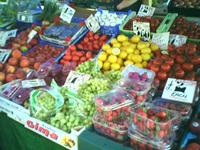
I came into some flak recently for suggesting that I didn’t like one of the soups that we had cooked. How could I have been so naïve as to criticise a dish while Blanca still had a knife in her hand? In order to avoid A&E we decided to, as with all great workmen, blame our tools. We looked at the pale, tough tomatoes that had just gone into our soup with and found our scapegoat.
Ripeness… what’s a guy gotta do these days? Short of growing and picking your own tomatoes, how can you get good fruit?
Ever since reading Jeffrey Steingarten’s “The man who ate everything”. I have been more aware (and more disappointed) by the ripeness of fruit in our supermarkets. The trend that we are all familiar with is that the ever successful supermarkets claim that the consumers are driving more diverse product ranges. As a result, the wholesaler to retailer distribution channel has to cope with greater distances. Greater centralisation and consolidation of stores results in greater quantity being pushed through these already tired channels. All of this has driven the requirement to pick more robust, durable fruit in order to survive the trip to the store. Unfortunately, durability is seldom analogous with fruit flavour.
Fruits live to ripen, this is what guarantees future generations. If fruits had their own reality show, all they would do is sit in the sun and wait for reproduction (eh, they may have their own show already). The process generally takes place during maturity and decline. Typical changes include colour, taste, aroma, size, weight, texture and nutritional content. Change in taste is what we're interested in here. The process entails the conversion of starch into sugar (sweeter and more desirable). Unfortunately, many fruits convert the starch from the plant (i.e. they don't have starch stores) and therefore will not get any sweeter once they are picked.[I]
The tricky part is that not all fruits are affected in the same way by this cutoff of sugar. As long as you shop in large supermarkets (we avoid them for fruit) you need to be aware of the risks that you are taking. That being said, being “forewarned is forearmed”, Steingarten categorises fruit according to their likelihood to ripen and improve off the vine:
| Never ripen after picking | soft berries, cherries, citrus, grapes, litchis, olives, pineapple, watermelon |
| Ripen only after picking | avocados |
| Ripen in colour, texture, but not sweetness | apricots, blueberries, figs, melons, nectarines, passionfruit, peaches |
| Get sweeter after picking | apples, kiwi, mangos, papayas, pears |
| Ripen in everyway after picking | bananas |
[II]
Category One receive all of their sugar from the parent plant. They may decrease in acidity, but will never get sweeter once off the vine. Category Two plants send a chemical that actually inhibit ripening, the fruit must be removed in order to stimulate the process. Category Three contain no starch, once off the vine, they will not create sweetness. These must be bought physically mature. Category Four have large supplies of starch, they improve in sweetness even off the plant. Category Five converts nearly all of its ample starch to sugar.
Depressingly for us, no one actually classifies tomatoes in the above matrix. From reading McGee, they seem to be a cross of Categories Three and Four. They do store starch in their wall tissue, but not as much as, say, apples. The rule of thumb should be to allow them ripen fully on the vine in order to have the fullest flavour[III]. This is sadly at odds with commercial reality. One tip that may help us; store tomatoes at about 10 C in order to maintain their flavour (due to a critical flavour compound, (Z)-3-dexenal, which disappears when chilled).

Our story ends well. We took at trip to Northcote Food Market and got some great plum tomatoes; red, meaty and perfect for cooking. Our second attempt at the soup was far more successful. It is taken from Celia Brooks Brown’s “Vegetarian Foodscape”.
1.25 kg fresh, ripe tomatoes
1 pint (600 ml) Vegetable stock
30 g Ginger, peeled and chopped
The sweet, meaty plum walls balance the more acidic (citric and malic) flavours and aromas of the jelly and skin. You don't need to peel. Additionally, don't worry about the loss of nutrients; almost 0% of minerals and about 5% of vitamins are lost during cooking tomatoes. Bring the tomatoes to the boil in the vegetable stock. Leave to simmer for 10 minutes. Add the remaining ingredients and simmer for 20 – 30 minutes. Puree the soup. Pass the whole thing through a sieve and serve.
Second time around, this was a fantastic soup. Really luxurious and smooth. I recommend plenty of pepper.
Sources
[I] Shirley O. Corriher "Cookwise"
[II] Jeffrey Steingarten "The Man Who Ate Everything"
[III] Harold McGee "Food & Cooking"
Note: This blog comes partly inspired by the UK's best food programme; “Full on Food”. Anyone who hasn't had the chance of seeing should watch it.
Technorati Tags: tomato soup ripeness food




No comments:
Post a Comment